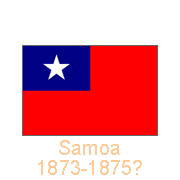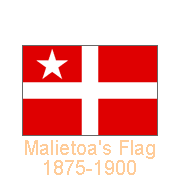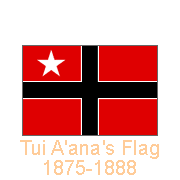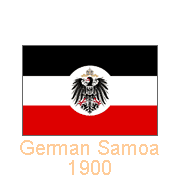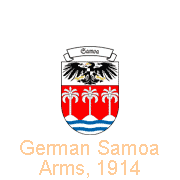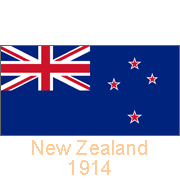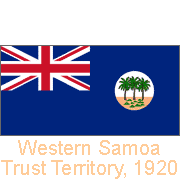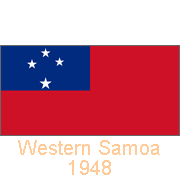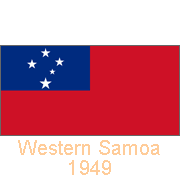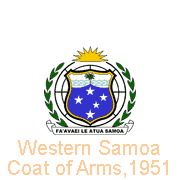Flags from Samoa

A Flag history of Samoa
Although Samoa had been sighted by Europeans for the first time in 1722, regular contact started only in the late 1830s with the arrival of English missionaries and traders. Although there is a claim about a red flag with a white crescent and star, this seems very unlikely: what is certain is that a flag displaying a white cross on a red background and a white star in the canton was adopted upon the establishment of the Kingdom of Samoa on 2 October 1873, although there also is a claim that a red flag with a blue canton and a white star was adopted that year, in use until 1875.
you may then send it as a postcard if you wish.
From 1875 the red flag with the white cross and star, symbolising Christianity and independence was in use, at least by the people who recognised Malietoa Laupepa, the paramount chief of Tuamasaga (central Upolu) as their leader; Malietoa was one of the three highest titles in (Western) Samoa. The other two titles were Tui Atua and Tui A'ana and its chief, Tamasese, favoured the German traders who now visited the country; he placed a black cross on top of the white one, so the flag now featured the German colours.
Malietoa Laupepa had been proclaimed "King" of Samoa in 1868, influenced by the British Consul and appointed "King of Samoa" on 7 February 1876 by the Consuls of the German Empire, the United States and the United Kingdom: a clear case of foreign manipulation. However, this was not accepted by the Atua and A'ana factions who set up their own government with Tupua Tamasese as King. The Germans favoured Tamasese and they banished Laupepa and his chiefs from his office in Apia after he had petitioned Queen Victoria for protection. Malietoa's red and white flag was hauled down in December 1885. On 15 September 1887 the German military forced Malietoa Laupepa and other chiefs to sign a document declaring Tui A'ana Tupua Tamasese Titimaea as "King of Samoa" and Laupepa was sent into exile. Tupua Tamasese's flag seems to have been a white field with a black cross and a red canton with a white star, making the German colours even more prominent. A civil war broke out in which Chief Matā'afa Iosefa, who had obtained the title of Malietoa in 1888, successfully fought against Tamasese and his German allies. Although installed as king, Germany, Britain, and the United States signed the General Act of Berlin on June 14, 1889, declaring Laupepa king once again, brought him back from exile and the red and white flag was hoisted once again.
The Second Samoan Civil War about succession to the kingship that had broken out in 1898 upon the death of Malietoa Laupepa got even more confusing with Germany, the United Kingdom and the United States locked in dispute over control of the Samoan islands. The Tripartite Convention of 1899 allocated German control over the western islands (presently independent Samoa) and the United States was given the eastern islands (presently American Samoa). On 1 March 1900 the black-white-red German flag (adopted in 1871) was hoisted in Mulinu'u, the government area in Apia. A colonial flag was used during the German Imperial administration, from 1 March 1900 until 29 August 1914, featuring the German black eagle, surmounted by the Imperial crown on a white disk placed over the black-white-red tricolour. The German government decided in 1914 that its colonies should have distinct Coats of Arms on its black-white-red flags. Various designs of the flag and arms were proposed, but were never actually used, as World War I interfered with Germany losing its colonies.
New Zealand troops invaded Samoa on 29 August 1914 on behest of the United Kingdom at the start of World War I; although Germany refused to surrender, no resistance was offered and New Zealand occupied the former German colony until 1920. During this time the New Zealand flag, a blue Ensign with four stars of the Southern Cross constellation on the fly, was flown. In 1920 Western Samoa became a "League of Nations Class C Mandate" of the United Kingdom, that delegated the actual governance of the country to New Zealand, then a British Dominion. An official Blue Ensign was introduced on 17 December 1920, depicting three palms on sandy soil, in a circle on the fly. There was also a Red Ensign of Western Samoa used from 30 July 1922 to 26 January 1925.
After World War II, on 24 October 1945, the United Nations was established and in December 1946 Western Samoa became a United Nations Trust Territory; with the agreement of the United Kingdom it was again placed under the jurisdiction of New Zealand, charged with promoting "the political, economic, social and educational advancement of the inhabitants and their progressive development towards self-government or independence". On 26 May 1948 Samoa adopted its own flag, designed by the two traditional chiefs Malietoa Tanumafili II and Tupua Tamasese Mea'ole: red with a blue canton and four white stars of the Southern Cross constellation, as in New Zealand's flag. Red symbolises courage, blue stands for freedom and white signifies purity, while the Southern Cross represents the geographical position of Samoa. On 24 February 1949 this was changed with a small fifth star added to the Southern Cross constellation. Western Samoa became independent on 1 January 1962 as the Independent State of Western Samoa; In July 1997 the country's name was changed to Independent State of Samoa.
A Coat of Arms was adopted in 1951 and, as it was a United Nations Trust Territory at the time, seems to have taken its inspiration from that of the United Nations: its background is the grid and olive wreath as in the UN badge, superimposed with a shield depicting the stars of the Southern Cross on a blue background and a green coconut palm on a green sea. The shield is surmounted by a golden sun and at the bottom is a scroll with the motto "Fa'avae i Le Atua Samoa", "Samoa is founded on God". After independence, on 1 June 1962, a change was made, with the background grid now red and the shield surmounted by a Christian cross, emphasising, like its motto, Samoa's Christian foundation.


